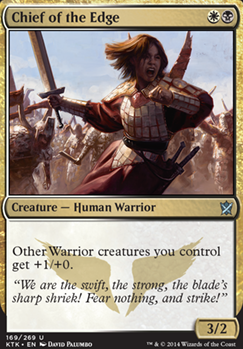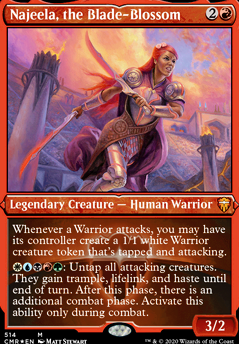Introduction
5C Warriors is a combat step combo deck. The deck was designed for a fairly casual metagame that stays fairly true to the 75% model. The primary use of the deck is in multiplayer games.
In general the deck aims to have the pieces for a win by the fifth turn of the game. There are some ramp options that enable a quicker kill, however this is fairly inconsistent. The purpose of the deck is to combo off and have infinite (though not actually infinite) combat steps, and win via combat damage.
The deck itself was designed in such a way that it can find all of its combo pieces relatively easily, but without the use of every tutor, by utilizing tribal based card draw. There was also thought put in that used lesser card choices in some instances to both maintain a warrior only creature base as well as restrict power level to a certain extent.
The Primer
Overview
Reading this decklist
Reading this decklist
Lands
These are fairly self-explanatory. Lands were picked that made it the easiest to color fix with a slight preference for green lands.
Ramp
This section includes cards that actively put me ahead on mana as well as things that help me more specifically with color fixing. It is important for the deck to have access to all five colors to some degree.
Creatures
The creatures in the deck help to support the combo finish by virtue of their creature type. Most were also picked specifically to act as color fixing, or to make blocking more difficult for my opponents. Some help to speed up the win with Haste or Vigilance.
Utility
These cards are here to try and keep the board under control while also limiting the effect on our own state. They also include our ability to dig for missing pieces, via one of raw card draw, draw filtering or tutoring.
Combo
The remaining pieces to the puzzle as it were are the combo pieces. They specifically support the end game plan of as many combat steps as is needed to win.
Deck colors
Deck colors
Najeela is the pinnacle of a journey I started four years ago, when I was first coming back into Magic. Khans of Tarkir was the hot new set and I built a standard Mardu Warriors deck. This deck was not very good. Several months after that my playgroup introduced me to Commander, I thought, "here we go. I can do something with this." I then proceeded to build a BW Warriors deck helmed by Athreos. This deck was not very good. Flash forward to the Partner commanders being released. Reyhan and Ravos allowed me to expand out into the uncharted territory of green ramp. This deck was okay. Side note: why isn't Saskia a warrior?
Najeela allows access to all warriors no matter their color identity and for this I am grateful. The best part of 5 color decks is the access to every legal card in the format. The mana base for a true 5 color deck is extremely difficult to balance, so the costs have been skewed heavily green as this provides the best fixing.
Deck strengths
Deck strengths
One of the biggest strengths of the deck is that the engine card is always available in the command zone. The card has the ability to come out early at 3 CMC (converted mana cost). The combo once setup will be able to win the game without disruption, and with the engine not having to join in on the attack this protects it further still.
We are able to go toe to toe with most aggressive decks and go wide decks, as the token generating potential of the deck is exponential, meaning if we can attack and survive a cycle we often have more than enough blockers to make combat tricky for our opponents. Stax decks are not as problematic as they could be due to our main wincon being with creature based mana production, and enough tokens that sacrifice effects are not as devastating.
The deck itself is able to fight through some level of hate, and has a clear and concise strategy that is fairly straight forward. Consistency is not an issue with the deck, but it was also designed with a slightly longer than cEDH (competitive Elder Dragon Highlander) type of game in mind. In my local meta, there is very little of the disruptive elements that go against the end goal, but it could be adjusted to better fight individual metas.
Deck weaknesses
Deck weaknesses
Probably the biggest weakness to the deck is how easily it can be disrupted with spot removal. Without the commander on the field the combo will fail to be realized.
Hard control decks are difficult to deal with. If they are able to keep our commander off of the table it becomes increasingly difficult to win. Other combo decks also tend to be an issue as we skew away from blue we have fewer answers to what others at the table are doing.
Certain self-imposed restrictions have a negative effect on the overall power level of the deck. Redundant combo pieces were left out. No non-Warrior creatures were allowed in. Also tutors were kept to what I felt was the minimum. These things leave a deck that is purposefully less explosive then it likely could be.
The Strategy
General strategy
General strategy
In general the plan is to go to combat with enough mana production to get WUBRG mana. The deck is setup in that if you can do it once, you can do it until you are victorious or you disrupted. Every turn you should be either ramping or attacking. A healthy side effect of the combo is infinite mana. If an opponent is able to fog damage, you can still utilize other elements to win the game.
The only type of decks an opponent can play that will force you to change plans are other creature decks. The plan of being able to attack after attack falls apart if the other players all have 2/2s that brick wall your attacks as you need warriors to survive to continue to expand. Typically in multiplayer games there is someone with little board state that can act as a starting place to build up your forces.
Early game
Early game
Generally in the early game you are trying to establish a board presence, with a mana enabler active. As such a perfect opening hand tends to include land ramp and card draw. We always have a three mana plan with our commander so that helps to shape some hands, as we truly have 8 cards in our opener.
Mid game
Mid game
Unlike some combo decks this does try and go off and win in the mid game. It wants opponents to have as little board presence as possible so it can attack through for the win. If we are not established and ready to combo then the mid game becomes slightly political, in the let me attack you to make a token so that I can use that to draw cards manner. If we haven't won by the mid-point then we start to shift into card draw to try and overwhelm our opponents or clear at least one of their boards.
Late game
Late game
Full transparency, if we make it to the late game we are not likely to win. This deck tends to run low to the ground and as such is lighter than most on catch-up mechanisms. By the late game you just have to sit back and try and be as non-threatening as possible. If an opponent is weakened by another but not killed, this will occasionally open the door to allow us to come back.
Card Choices Explained
Lands
Lands
This deck uses all 10 ABUR dual lands alongside all 10 Fetchlands as this is the best form of color fixing.
Cascading Cataracts and Crystal Quarry both work with mass land untappers to maintain WUBRG
Vault of the Archangel is here primarily to discourage blocking and help out when stuck at or near parity
Creatures
Other cards
Other Information
Building this deck
Building this deck
The deck itself has the ability to shape and shift like many 5 color decks are able. The beauty of this type of deck is that by its nature it is extremely meta flexible. For a more competitive environment you may wish to dedicate more space to disruption and artifact ramp. For a less competitive meta you can probably deal with more tri-lands and others that enter tapped, this also helps with the budget. There are no cards in this build of the deck that were restricted based on budget. That isn't to say there are not cards that would make this more competitive, as I'm sure if you get away from some of my restrictions you would find more avenues for advancement.
Event record
Event record
Event recording has not been started but will be coming soon
Change log
Change log
v1.0.0: This is the initial version of this list and primer. Updates will follow as necessary
Feedback
Any and all feedback and support is greatly appreciated. Please feel free to comment down below and I'll try and keep everyone that is interested updated, for as long as they care. Take care and thanks for reading!
The coding for this primer was developed by
Epochalyptik here.






